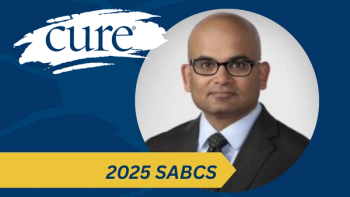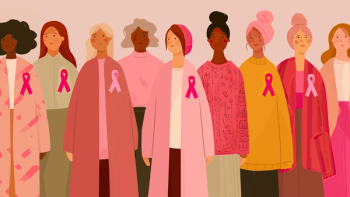
- Fall 2008
- Volume 7
- Issue 3
Finding Your Compass
New research and tools illuminate the multiple treatment paths faced by patients with early-stage invasive breast cancer.
One evening about 18 months ago, Debjani Dutta stepped out of the shower, rubbed herself down with moisturizer—and felt a small lump on her right breast. It was a crazy time for the family. Dutta’s boys were 5 and 7. The roof on their home in Fremont, California, needed replacing. She had a meeting early the next morning. And then, she found a lump.
“My heart almost stopped beating,” Dutta says today. “I tell you, that was about the scariest moment of my life.” Dutta, 38, a scientist at Genomic Health, had been working for five years on Oncotype DX, a genetic assay of tumor tissue used to help women, doctors, and researchers understand a breast cancer patient’s risk of recurrence and response to chemotherapy.
“I knew what it could be,” Dutta says. Her mind whirred. Was it cancer? If so, would it be estrogen receptor-positive or negative? What stage? What level of HER2 gene expression? Any positive lymph nodes? How many? The answers, Dutta knew, could dramatically change her prognosis and course of treatment—if it was breast cancer.
It was—stage 1C estrogen receptor-positive, HER2-negative, invasive ductal carcinoma.
Treatment for early-stage breast cancer (stages 1 and 2) has entered a bewildering era, even for experts such as Dutta, with new drugs on the horizon, old drugs under scrutiny for use in particular types of patients, new diagnostics based on tumor genetics, and new treatment regimens.
But with the confusing proliferation of tests and treatment options also comes specificity. Researchers are beginning to learn who will benefit from each treatment option—from chemotherapy and hormonal therapy to more targeted anti-cancer drugs—and who will not.
That’s important, because as more women live for many years after breast cancer, researchers following them are realizing that some cancer treatments themselves carry long-term risks of heart disease and secondary cancers. Why accept those risks if the characteristics of the tumor—or the patient’s own genes—suggest she’s not likely to benefit?
“The goal is to erase the unwanted and unnecessary use of chemotherapy,” says Paul Goss, MD, PhD, director of Breast Cancer Research at Massachusetts General Hospital and a professor at Harvard Medical School. “It’s almost like a teacher punishing the entire class of children instead of finding that one person that whispered. We’ve been punishing the whole class, not knowing who the culprit is. But we are gradually moving toward personalized medicine.”
Clinical trials for new therapies or treatment regimens often begin with high-risk patients or those with more advanced tumors, which makes it difficult for doctors to apply that data to other types of patients and cancers. Several clinical studies evaluating early-stage breast cancer genetics and treatment regimens won’t deliver results for several more years. So for now, controversies emerge as researchers and clinicians try to extrapolate from studies focused on larger tumors to figure out what’s most likely to work best for early-stage patients, and least likely to cause complications.
Anthony Elias, MD, a professor of medical oncology at the University of Colorado Denver School of Medicine, says if the risk of recurrence is low in the first place, the further reduction in risk is going to be quite small. For smaller tumors, the marginal benefits from aggressive treatment may not balance out the risk of chemotherapy-induced heart failure, leukemia, or other severe side effects, he says.
As breast cancers are diagnosed at earlier stages, you have to decide at what point chemotherapy is still worthwhile, especially if you don’t have the clinical data, Elias says. “It’s about the balancing of risk and benefit, and sometimes there are debates in the gray zones.”
Some of those controversies include: When is adjuvant (post-surgery) chemotherapy warranted and when is it not? Who benefits enough from treatment with anthracyclines, given the sometimes-severe side effects of those chemotherapy drugs? Anthracyclines, including Adriamycin (doxorubicin) and Ellence (epirubicin), have been used for years, but they create a long-term risk of serious heart damage (2 to 7 percent based on the dose) and leukemia (about 1 percent versus normal risk of about 0.2 percent).
Questions also abound concerning the best treatment for cancers that thrive on estrogen. Women with estrogen receptor-positive cancers often take drugs for several years to keep estrogen from feeding any cancer cells that remain after surgery. For how long should doctors use the most common drug, tamoxifen, given that cancer can develop resistance to the drug? When should newer drugs called aromatase inhibitors be used instead of tamoxifen—or following it? And for how long?
“It really starts to become extraordinarily confusing,” says Laura Siminoff, PhD, chair of the Department of Behavioral Sciences and Health Promotion at Virginia Commonwealth University’s School of Public Health. Breast cancer patients are now divided into various categories, including estrogen receptor-positive or negative, premenopausal or postmenopausal, HER2-positive or negative, Siminoff says.
“The question is how much information can any one patient understand?”
She and other decision-making experts break it down carefully for patients, creating lists of questions and answers to guide women through choices about adjuvant chemotherapy, hormonal therapy, and other targeted therapies—or none.
The overall goal, Siminoff says, is to make sure patients understand the benefits and risks they’re balancing. A certain flavor of adjuvant chemotherapy, for example, might reduce the average chance of cancer recurrence for a specific patient population from 30 to 25 percent—a 5 percent improvement. But if a patient’s risk of congestive heart failure from treatment is higher than 5 percent—as it may be for older women with certain types of cancer taking certain drugs—is it worth it?
I envisioned this system being used by doctors to share information with their patients. We know that people have better outcomes when they understand things better, when they make decisions for themselves.
Siminoff helped develop Adjuvant! Online, a tool conceived by Peter Ravdin, MD, PhD, of M.D. Anderson Cancer Center in Houston. Siminoff and her colleagues hoped doctors would use Adjuvant! Online to explain the risk of recurrence to patients. Doctors enter as much information as is available on a person and her cancer, from staging, size, and number of positive lymph nodes to a woman’s age. The computer program pulls data from clinical studies and draws bar graphs showing how women of similar age with similar cancers fared on average—without chemotherapy, with various chemotherapy agents, with hormonal therapy, or with both.
“I envisioned this system being used by doctors to share information with their patients,” Siminoff says. “We know that people have better outcomes when they understand things better, when they make decisions for themselves.”
From her research, Siminoff also knew that without guidance, patients generally overestimate—sometimes greatly—the potential benefit of chemotherapy. In one of her studies, many women expected chemotherapy would result in a nearly 80 percent reduction in their risk of recurrence—several times higher than best scientific estimates. Such exaggerated expectations may lead to inappropriate decisions, Siminoff says.
In March, Siminoff’s sister Julie Sisskind, 47, was diagnosed with stage 2B estrogen receptor-positive breast cancer. She also learned she had the BRCA2 gene, which carries an increased lifetime risk for breast and ovarian cancers. Sisskind opted for a double mastectomy—the first in a relentless train of decisions.
“So then my sister ran her program for me,” Sisskind says. Without further treatment, Adjuvant! Online indicated she had a very high chance of recurrence—about 50 percent in the next 10 years. With chemotherapy, that might drop to 26 percent, according to Adjuvant! Online, and with hormonal therapy, it would drop just below 20 percent.
Sisskind, the mother of two teenagers, wanted any additional benefit she could get to treat her fast-growing cancer, so she decided to take both chemotherapy and hormonal therapy. But which combination?
The convention would say AC for chemotherapy—Adriamycin (doxorubicin) and Cytoxan (cyclophosphamide). But new research presented at last year’s San Antonio Breast Cancer Symposium indicated that for early-stage cancers, a combination of Taxotere (docetaxel) and Cytoxan, or TC, works as well or better, and is far easier on the heart.
Pathologists found a high fraction of proliferative cells in Sisskind’s tumor, so to gather more information about the benefit from chemotherapy, doctors also ran a sample of Sisskind’s cancer tissue through a genetic assay called Oncotype DX (the assay Dutta helped develop).
Oncotype DX measures the expression of 21 genes in cancer cells from early-stage estrogen receptor-positive, node-negative disease, and generates a recurrence score shown in clinical studies to be an accurate predictor of recurrence risk and predictive of a tumor’s response to chemotherapy. Patients with a high Oncotype DX recurrence score are more likely to benefit from chemotherapy than those with a low score.
View Illustration: Treatment By Numbers
Sisskind had not received her score as of press time, but suspecting it would be relatively high, she picked chemotherapy that contained Adriamycin. “I’m not older, I don’t have a lot of other risk factors for heart disease … so the benefits of Adriamycin seemed to outweigh the risks,” she says.
Sisskind says she may also add Taxol (paclitaxel) to her treatment regime. In early-stage patients at high risk for recurrence, Taxol and Taxotere have shown promise, although there is some controversy over their effectiveness. In a phase III study published in April in The New England Journal of Medicine, weekly Taxol given with standard chemotherapy improved survival rates, and Taxotere every three weeks improved disease-free survival. A study published late last year in the same journal, by contrast, showed Taxol given after the AC combination benefits only patients with HER2-positive or estrogen receptor-negative tumors and does little for patients with HER2-negative, estrogen receptor-positive cancers.
Sisskind will soon decide whether she will take hormonal therapy to cut off the supply of estrogen to any remaining cancer cells. She’ll probably start with tamoxifen, she says.
Newer drugs called aromatase inhibitors—Arimidex (anastrozole), Aromasin (exemestane), and Femara (letrozole)—are effective at fighting estrogen-sensitive cancers and have fewer side effects than tamoxifen, but they’re not indicated for premenopausal women. Aromatase inhibitors, or AIs, can’t shut off estrogen production in the ovaries. Rather, they block conversion of androgens to estrogen, a mechanism that can contribute to bone loss over time.
Sisskind will eventually have her ovaries removed because of her high risk for ovarian cancer as a BRCA2 carrier, so she might become a candidate for the AIs. “But I know I have time on that one,” she says. “We don’t have to decide it today.”
Dutta faced a similar set of decisions, but her risk of recurrence was slightly lower. Like Sisskind, she had an estrogen receptor-positive, HER2-negative cancer, but it was caught earlier. Dutta’s sentinel node came back negative for cancerous cells, a fact the surgeon whispered into her ear as she was recovering, still unable to open her eyes, but able to hear.
“He said, ‘Debjani, I know you want to know this—node-negative.’ I could not even smile, but I wished I could give him a hug,” she says.
Dutta wrestled with the decision about chemotherapy. “I knew radiation and tamoxifen were coming. Chemo was the thing for me. I thought, ‘Do I really need this chemotherapy, this poison to my body?’ ”
She and her doctors used Adjuvant! Online and Oncotype DX to evaluate her recurrence risk, which was “intermediate,” Dutta says. Hormonal therapy was likely to lessen that risk substantially, and adding chemotherapy on top of that might give her a few more percentage points of benefit.
“In the end, I favored the more aggressive and toxic treatment because I wanted to see my sons go to college,” Dutta says, adding she thought of it as pushing her risk farther into the future. She could accept a small increase in the chance of heart disease or cancer 20 years in the future in return for a smaller chance of breast cancer’s return sooner.
After reviewing the treatment options, though, Dutta didn’t have to accept those long-term risks associated with Adriamycin and other anthracyclines. With earlier staging and no positive nodes, she was a strong candidate for the TC regimen. Trials show Taxotere to be highly effective, and although it is associated with a risk of side effects such as neutropenia and diarrhea, it doesn’t cause permanent heart damage or additional risk of cancer.
Joyce O’Shaughnessy, MD, co-director of US Oncology’s Breast Cancer Research and a practitioner with Texas Oncology in Dallas, says many oncologists believe Adriamycin is “on the chopping block,” at least for use in low-risk women.
“There’s toxicity, the short-term risks, which are not to be sneezed at, and there’s this low, very low risk of cardiac failure or secondary leukemia. I think its time has come,” she says.
Herceptin (trastuzumab) is a powerful targeted agent used against the 20 to 25 percent of patients with HER2-positive breast cancer. It was approved a decade ago for metastatic breast cancer, and in 2006, early-stage breast cancer became an approved indication for the drug. Herceptin causes heart damage in rare instances, but the damage appears to usually reverse itself. Tykerb (lapatinib), another HER2-targeted agent approved in the metastatic setting, is currently being tested in early-stage disease.
In several more years, O’Shaughnessy says, women in Dutta’s position—with node-negative, estrogen receptor-positive cancers—will have another key study to help in adjuvant therapy decision-making. Sponsored by the National Cancer Institute, TAILORx (Trial Assigning IndividuaLized Options for Treatment) is trying to separate women with an Oncotype DX-identified intermediate risk of recurrence into those who benefit from chemotherapy and those who don’t.
Another prognostic test called MammaPrint, approved last year by the FDA, measures the activity of 70 genes in surgically removed breast tumors to help gauge the likelihood of recurrence. A clinical trial called MINDACT (Microarray in Node-Negative Disease May Avoid Chemotherapy) is currently under way in Europe to validate the clinical use of MammaPrint.
Because of her cancer’s estrogen-sensitive status, Dutta says she’ll also take tamoxifen, probably for five years. Estrogen receptor-negative patients are more likely to recur earlier than estrogen receptor-positive patients. If an estrogen-sensitive tumor does recur, it often happens six to 20 years later, O’Shaughnessy says.
And since cancer cells often develop resistance to tamoxifen, O’Shaughnessy says it’s important to understand whether a woman’s risk of recurrence is highest in the first five years.
“Breast cancer is a very heterogeneous disease,” she says. “Here’s my strategy: If your risk is in the first five years, you have a fast-growing tumor. You want to load up with the very best drug up front, and that’s the aromatase inhibitors. For more indolent disease, I’m a switcher.”
For slower-developing cancer, she and many other oncologists now give postmenopausal patients tamoxifen for several years and then switch to an aromatase inhibitor because clinical studies show that strategy prevents more cases of recurrence.
The array of trial results and treatment options has become so complex that patients need but don’t always get guidance through the bewildering process of treatment decisions, says Jeffrey Belkora, PhD, director of Breast Care Center Decision Services at the University of California, San Francisco.
“On one hand, if all you care about is increasing survival, the news with breast cancer is almost all good,” Belkora says. “On the other hand, if in addition you care about quality of life, optimizing things like the long- and short-term side effects of treatment, how it’s going to affect your ability to work, your function in your family … there are trade-offs with all these treatments. With a little extra work, you can often find something that is better tailored to you.”
Through Belkora’s program at UCSF, Dutta met twice with a pre-medical intern to list key questions she needed answered before making her decisions. Before her oncology appointment, she also watched a short educational video. Her pre-med intern attended the oncology meeting with Dutta, took notes for her, and audio-recorded the oncology meeting so Dutta could review the recording to be sure she didn’t miss anything.
“There’s so much information coming at you, and it’s an emotional time,” Dutta says, adding the intern was a big help.
Belkora has demonstrated significantly higher satisfaction in patients and physicians when patients were prepared before appointments. He suggests patients ask their oncologists about Oncotype DX, Adjuvant! Online, and any other prognostic models that can or should be used to guide decisions.
Even researchers admit the details can get difficult to keep straight. “We’re all moving into a more complicated world, and we’re using more and more tools online,” Goss says. “The Internet is our work colleague, our personal assistant, our Encyclopedia Britannica.”
Articles in this issue
over 17 years ago
Message from the CURE Staffover 17 years ago
Understanding Preventive Mastectomyover 17 years ago
International Thyroid Cancer Survivors' Conferenceover 17 years ago
Breaking Down TCMover 17 years ago
Olympian Postpones Treatment to Competeover 17 years ago
New Pharmacy Breed Offers Special Attention, Drawbacks to Patientsover 17 years ago
www.SharingHope.tvover 17 years ago
Q&A: Vitamin Dover 17 years ago
Web Exclusive: Preventing Breast Cancerover 17 years ago
Never Fear



